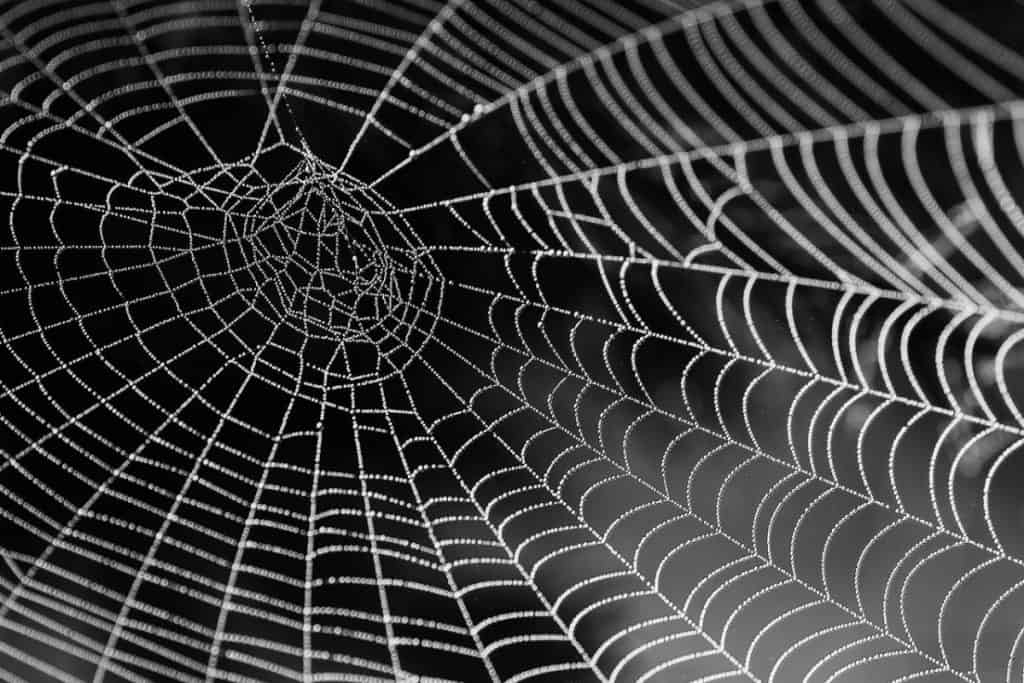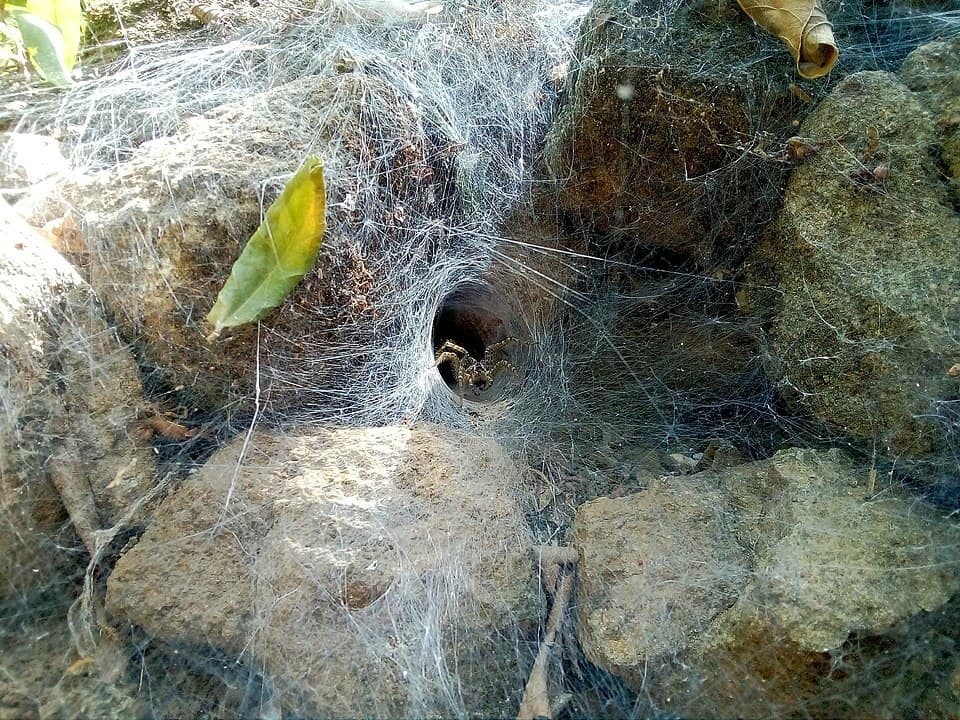
If you enjoy reading this article, why not check out our articles on Do Spiders Hibernate? Let’s Find Out and When is Spider Season? The Quick Answer
What is meant by a male spider web?
When it comes to spiders, it’s fair to say that females have it easier. They’re bigger, stronger, and they can stay in one place all their lives. Males, on the other hand, are smaller, have to travel a lot, and they may get eaten by their mate. You might have also heard that male spiders can’t spin webs. But is it true?
Speaking of small spiders, you should check out our article How Small Can Spiders Get? to learn about some really tiny spiders!
Male spiders can spin webs
Yes, But their lifestyle isn’t one where web-weaving is necessary. That’s why they don’t build webs as often as female spiders do.
That said, male spiders do spin their own webs from time to time. Every species is different. Some males have clever uses for the silk they produce.
Do Male Spiders Spin Webs?
The myth that male spiders can’t spin webs comes from the fact that they don’t do it a lot. If you see a spider on a web, you’re likely looking at a female spider. Why? Because most male spiders aren’t territorial. Rather, they spend their lives moving around looking for mates.
Because male spiders are always on the move, a web to call home wouldn’t make much sense. Why use up their precious energy building a one when they’re going to abandon it anyway? This is why you won’t find older male spiders building webs. Younger males build their own webs before they go searching for females. But these webs are never as impressive as female spider webs are.
But that’s for most male spiders, not all. There are thousands upon thousands of species of spiders. And they all differ from one another, sometimes in amazing ways.
Can all spiders spin webs?
Some species’ males don’t build webs at all, while others can build intricate web traps. If you have a pet spider, it’s best to study that particular species to learn if they will build a web or not. If you’re interested in getting a pet spider but not sure where to start, read through The Three Best Spiders to Keep as Pets for inspiration.
In short, webs aren’t of much use to male spiders. For females, it’s a whole different story. Webs are the life and home of a female spider. This is where they live, eat, and breed all their lives. That’s why they put so much effort into constructing a strong and beautiful web. With this, female spiders never have to move. Their food and their mates come to them, they don’t have to go looking for it.
Why Do Spiders Spin Webs?

Why do male spiders even bother building webs at all? If they’re going to spend their lives running after females, what’s the use of their silk?
Reasons to build webs
- The primary use of a spider web is to catch prey. While spiders can hunt, most of them get their meals by trapping.
- Spider webs are sticky and very difficult to see. That’s why unlucky insects fly straight into it and can’t get out.
- The spider will then swing over to the trapped insect, wrap it in silk, then suck its blood.
Why do tarantulas spin a web?
Other species, such as tarantulas, use their silk to build trap doors. These spiders first burrow into the ground. They then spend a lot of time weaving silk and soil together to make the perfect trapdoor. This completely camouflages their burrow and allows them to jump out in the blink of an eye. When an insect gets too close, tarantulas can spring out, grab the prey, and drag it inside. Tarantulas are fascinating. To learn more about Rose Hair Tarantulas, read Everything You Need To Know About Rose Hair Tarantulas.
Spiders spin two kinds of silk
- Sticky silk or viscid silk
- Non-sticky silk or dragline silk
Some spiders even use their silk to create nets. Since spider silk is flexible, these nets can expand wide. The spider can then throw their net at their prey, and there will be no way out.
You get the idea. Spiders use their webs to catch food. That’s why even though young males don’t stay in one place, they build webs to eat.
Why do male spiders spin webs?
But what about the older males who don’t build webs anymore? Some of these spiders still go hunting, but others eat from the female’s web instead. Males sometimes share the web and prey of their mate. Other times, the male is the prey. After mating, the female then proceeds to devour the male. This gives her the energy she needs to give birth.
But it isn’t only webs and traps that spiders use their silk for. Like Spiderman, spiders also use their webs to get around. They can use their web to swing and climb from plant to plant. This helps male spiders find a mate a lot faster. They can also use their webs to help them get away from predators.
How do Spiders Spin Webs?
We all know that spiders can spin webs, but have you ever wondered how they do this? Or what these webs are made of?
Spider silk isn’t like any other silk. It is made from crystals and amino acids, making it extremely strong and flexible. The only reason we can break spider webs is that they are super thin.
If you think of it, very few other materials can hold together as well as spider silk does. In fact, spider silk is tougher than steel! That’s how amazing spider webs are.
Spiders can produce 6 different types of silk. And in webs, some areas are sticky and some that aren’t. This is what allows spiders to move freely around their web, while insects get stuck on it.
Spiders have a special gland on their abdomen that produces this silk. They then use their long legs to skillfully weave it. If you’ve ever seen a spider at work, you know what a fascinating process this is. They create webs, cocoons, traps, and climbing lines.
What’s the Difference Between Spider Webs and Cobwebs?
As beautiful as spider webs can be, you won’t want them in your home. House spiders are completely harmless, and they do help kill insects. But if you want your house to be clean, you should get rid of their webs. This is especially true when it comes to abandoned webs. Abandoned webs catch a lot of dust. This can look very dirty.
That’s the difference between spider webs and cobwebs like,
- Spider webs are fresh and occupied. They are maintained by the spider that built them. That’s why they are always in good shape.
- Cobwebs, on the other hand, are webs that have been abandoned. Without any spider keeping them, cobwebs gather dust and need repairs.
A lot of cobwebs are created by male spiders. Remember, male spiders don’t stay in one place. That is why they will eventually leave the web that they have built. Abandoned, this web turns into a cobweb.
What’s the Difference Between Male and Female Spiders?
If you have a pet spider, you might be wondering whether it is a male or a female.
| Characteristics of spider | Male | Female |
| Size | large | larger than male |
| Sets of legs | longer | shorter legs than male |
| Color | bright color | more colorful than females |
| poisonous | poisonous | more poisonous than male |
| Age | shorter life | female spiders live longer |
| palps | short palps | long palps |
Since it’s a pet, you probably keep it in an enclosed space. So you won’t be able to tell its sex by its behavior since the males won’t have anywhere to roam. But there are other ways that you can tell.
One way you can guess is by looking at the web. A pet male spider may or may not build a web. Either way, it won’t be as good as a female spider’s. Those really beautiful and intricate webs are only made by females. The following are the common points to evaluate the difference between male and female spiders.
- For most species of spiders, the females are bigger than the males. Sometimes, this difference in size is huge. Other times, they’re almost similar.
- There are very few species of spiders where the males are actually larger than their female counterparts. This is because of the role of male spiders. After mating, they’re going to run away to avoid being eaten. This is why being small is an advantage for males, it allows them to get away faster.
- Another way you can differentiate between male and female is by their palps. If you take a close look at spiders, you’ll notice two small projections near their mouths. These are known as palps. Females have long, thin palps, while males have bloated palps. This is where they store the sperm they use for mating.
- Male spiders usually have longer legs than females. You can probably guess why by now. These long legs were perfectly designed for their endless roaming. These long legs allow male spiders to travel faster. It also makes it easier for them to hunt and to escape predators. Since females stay at home, they don’t need long legs. What they have instead, is more venom. This makes it easier for females to defend their web.
- Another characteristic of male spiders is that they are often more colorful. Males have to attract a mate somehow, and some of them turn to flashy colors to do this. You’ll find that in a lot of species, the males are bright and vivid, while the females are dull.
Conclusion
If you want to be sure, do a little research on the exact species of spider that you have. Spiders are one of the most diverse types of animals on the planet. What may be true of one species might be completely false for another. So check what type of spider you have to know whether it is a male or female.
If you enjoyed reading this article, why not check out our articles on Everything You Need to Know About Rose Hair Tarantulas and How Many Spiderlings Can a Spider Have?

